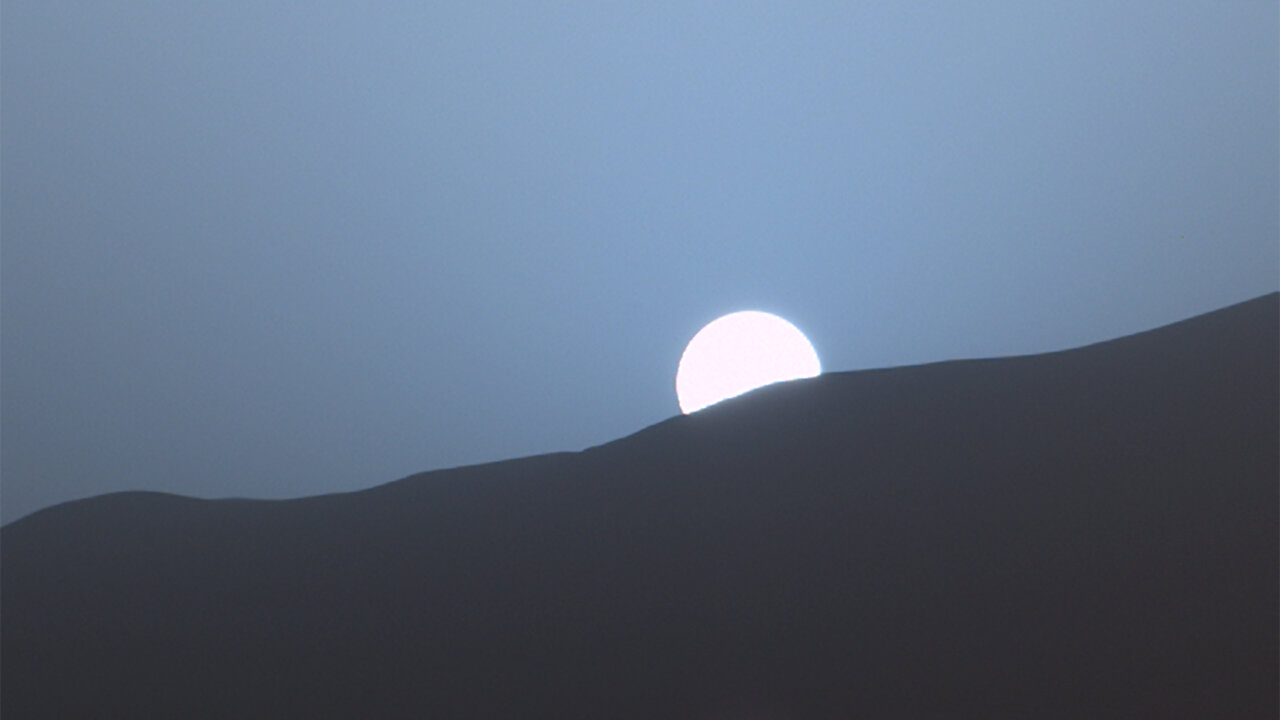Premium Only Content

Som ET - 78 - Mars - Sunset on Mars - Perseverance, Curiosity and Spirit
Mastcam-Z's First Martian Sunset (Perseverance)
This sunset on Mars was captured by NASA's Perseverance Mars rover using its Mastcam-Z camera system on Nov. 9, 2021, the 257th Martian day, or sol, of the mission.
Martian sunsets typically stand out for their distinctive blue color (https://solarsystem.nasa.gov/news/925/what-does-a-sunrise-sunset-look-like-on-mars/). Fine dust in the atmosphere permits blue light to penetrate the atmosphere more efficiently than colors with longer wavelengths. But this sunset looks different: less dust in the atmosphere resulted in a more muted color than average. The color has been calibrated and white-balanced to remove camera artifacts.
NASA Image: https://mars.nasa.gov/system/downloadable_items/46754_PIA24935.jpg
--------------------------------------------------------------------
Sunset at Mars' Gusev Crater (Spirit).
On May 19th, 2005, NASA's Mars Exploration Rover Spirit captured this stunning view as the Sun sank below the rim of Gusev crater on Mars.
This Panoramic Camera (Pancam) mosaic was taken around 6:07 in the evening of the rover's 489th martian day, or sol. Spirit was commanded to stay awake briefly after sending that sol's data to the Mars Odyssey orbiter just before sunset.
This small panorama of the western sky was obtained using Pancam's 750-nanometer, 530-nanometer and 430-nanometer color filters. This filter combination allows false color images to be generated that are similar to what a human would see, but with the colors slightly exaggerated.
In this image, the bluish glow in the sky above the Sun would be visible to us if we were there, but an artifact of the Pancam's infrared imaging capabilities is that with this filter combination the redness of the sky farther from the sunset is exaggerated compared to the daytime colors of the martian sky.
Because Mars is farther from the Sun than the Earth is, the Sun appears only about two-thirds the size that it appears in a sunset seen from the Earth.
The terrain in the foreground is the rock outcrop "Jibsheet," a feature that Spirit has been investigating for several weeks (rover tracks are dimly visible leading up to "Jibsheet"). The floor of Gusev crater is visible in the distance, and the Sun is setting behind the wall of Gusev some 50 miles (80 kilometers) in the distance.
This mosaic is yet another of a beautiful, sublime Martian scene that also captures some important scientific information.
Sunset and twilight images are occasionally acquired by the science team to determine how high into the atmosphere the martian dust extends, and to look for dust or ice clouds. Other images have shown that the twilight glow remains visible, but increasingly fainter, for up to two hours before sunrise or after sunset. The long martian twilight (compared to Earth's) is caused by sunlight scattered around to the night side of the planet by abundant high altitude dust. Similar long twilights or extra-colorful sunrises and sunsets sometimes occur on Earth when tiny dust grains that are erupted from powerful volcanoes scatter light high in the atmosphere.
NASA Image: https://solarsystem.nasa.gov/system/downloadable_items/3023_PIA07997.jpg
--------------------------------------------------------------------
Sunset at Mars' Gale Crater (Curiosity)
NASA's Curiosity rover captured this sunset view at Mars' Gale crater in 2015.
This was the first sunset observed in color by Curiosity. The images come from the left-eye camera of the rover's Mast Camera (Mastcam). The color has been calibrated and white-balanced to remove camera artifacts. Mastcam sees color very similarly to what human eyes see, although it is actually a little less sensitive to blue than humans.
The rover's imaging team assembled a four-image sequence of the sunset over a span of 6 minutes and 51 seconds.
Dust in the Martian atmosphere has fine particles that permit blue light to penetrate the atmosphere more efficiently than longer-wavelength colors. That causes the blue colors in the mixed light coming from the Sun to stay closer to Sun's part of the sky, compared to the wider scattering of yellow and red colors.
The effect is most pronounced near sunset, when light from the Sun passes through a longer path in the atmosphere than it does at midday.
NASA Image: https://solarsystem.nasa.gov/system/downloadable_items/3025_PIA19401.jpg
Audio: Som ET - 78 - Mars
Credit: NASA/JPL-Caltech/ASU/MSSS/Texas A&M Univ/Cornell
#nasa #mars #curiosity #perseverance #marte #марс #火星 #मंगल #মঙ্গল #المريخ #ดาวอังคาร #مریخ
-
 LIVE
LIVE
MYLUNCHBREAK CHANNEL PAGE
7 hours agoDilmun: Where Life Never Ends
1,143 watching -
 LIVE
LIVE
Twins Pod
4 hours agoEMERGENCY PODCAST WITH ANDREW TATE! - Twins Pod - Special Episode - Andrew Tate
5,366 watching -
 LIVE
LIVE
Jewels Jones Live ®
1 day agoTRUMP SECURES BORDER | A Political Rendezvous - Ep. 113
2,349 watching -
 25:02
25:02
marcushouse
17 hours ago $29.35 earnedStarship Just Exploded 💥 What Went Wrong This Time?!
75.4K45 -
 12:00
12:00
Silver Dragons
22 hours agoBullion Dealer Reveals Best Silver to Buy With $1,000
35.8K7 -
 12:58
12:58
NinjaGamblers
7 hours ago $10.66 earnedIs This The BEST Way to Win At Roulette? 😲
67.8K4 -
 1:01:54
1:01:54
CharLee Simons Presents Do Not Talk
2 days agoCALIFORNIA'S DONE!
36.3K17 -
 7:33
7:33
MudandMunitions
1 day agoUnboxing My FIRST Revolver! Smith & Wesson 442 .38 Special and What’s Coming Next for the Channel
56.9K7 -
 1:01:05
1:01:05
Trumpet Daily
1 day ago $7.21 earnedGermany Started Two World Wars and Now Wants Nuclear Weapons - Trumpet Daily | Mar. 7, 2025
42.5K65 -
 57:07
57:07
Stephen Gardner
22 hours ago🚨BREAKING: Musk STUNS even Trump with LATEST FRAUD DISCOVERY!!
167K398